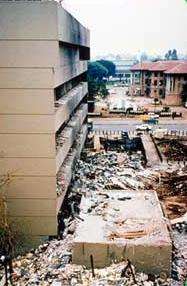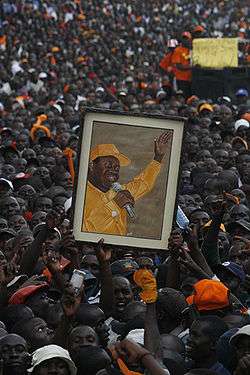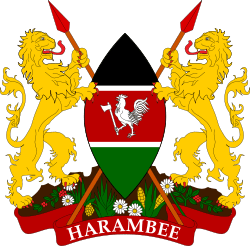Crime in Kenya

There is a high rate of crime in all regions of Kenya, particularly in Nairobi, Mombasa, Kisumu, and coastal beach resorts. There are regular reports of attacks against tourists by groups of armed assailants.[1] However, the most common crime in Kenya is carjacking so the criminal can commit an armed robbery. "Snatch and run" crimes are becoming more common on city streets.
Crime by type
Carjacking
The most common crime in Kenya is carjacking to commit an armed robbery.[2] In early 2007, two US citizens were killed and one critically injured in two separate carjacking incidents.[1] Nairobi averages about ten vehicle hijackings per day, while Kenyan authorities have limited capacity to deter or investigate such acts.[1] Matatus (public transportation) tend to be targeted since they carry up to 14 passengers.[1]
Although these attacks are often violent, victims are generally not injured if they do not resist.[1] However, victims are sometimes tied up and put in the back seat or trunk of their own car.[2] Criminals who commit these crimes will not hesitate to shoot a victim who is the least bit uncooperative or who may appear to hesitate before complying with their assailant.[2]
Theft and banditry
Pickpockets and thieves carry out "snatch and run" crimes on city streets and near crowds.[1] There have been reports of safes being stolen from hotel rooms and hotel desk staff being forced to open safes.[1]
Thieves routinely snatch jewellery and other objects from open vehicle windows while motorists are either stopped at traffic lights or in heavy traffic.[1] Thieves on matatus, buses and trains may steal valuables from inattentive passengers.[1] Many scams, perpetrated against unsuspecting tourists, are prevalent in and around the city of Nairobi.[1] Many of these involve people impersonating police officers and using fake police ID badges and other credentials.[1] Nevertheless, police checkpoints are common in Kenya and all vehicles are required to stop if directed to do so.[1]
There has been an increase in armed banditry in or near many of Kenya's national parks and game reserves, particularly the Samburu, Leshaba, and Masai Mara game reserves.[1] In response, the Kenya Wildlife Service and police have taken some steps to strengthen security in the affected areas, but the problem has not been eliminated.[1] Travelers who do not use the services of reputable travel firms or knowledgeable guides or drivers are especially at risk.[1]
Although sometimes confused with the similarly-named North Rift Valley region, where cattle rustling and banditry is common, the separate North Eastern Province has been relatively peaceful since the appointment of its former Provincial Commissioner, Mohamoud Saleh. During his time in office, Saleh established an effective security committee consisting of clan elders and leaders, and worked closely with community members to assure security. Owing to the success of this "Saleh Strategy", the Garissa Peace and Development Committee (GPDC) in 2010 hosted several high-level delegations from adjacent nations such as Uganda, and shared its experiences in community building. According to Interpol, the NEP's commercial hub of Garissa is also one of the safest areas in the larger eastern Great Lakes region.[3]
Ethnic violence

Kenya is generally a peaceful and friendly country in its political activism, it is nonetheless common during elections, referendums and other political votes for campaign violence to occur around the country,[2] and ethnic clashes account for much of Kenya's problems.[4] An early example of this was during the 1970s, when tribal clashes killed thousands and left tens of thousands homeless, which allowed Daniel arap Moi to be re-elected in balloting, according to the United Nations Office on Drugs and Crime, "marred by violence and fraud."[4]
After 29 December 2007, the day after Kenya's National Parliamentary and presidential elections, violence erupted in major cities cross Kenya, including Nairobi, Mombasa, and Kisumu.[2] Clashes were reported throughout Kenya, which resulted in the deaths of over 600 Kenyans.[2] None of these incidents was targeted against the expatriate community.[2] [5]
Corruption
In the Corruption Perceptions Index 2007, Kenya was ranked 150th out of 179 countries for corruption (least corrupt countries are at the top of the list).[6] In 2007, on a scale of 0 to 10, with 0 the most corrupt and 10 the most transparent, Transparency International rated Kenya 2.1.[6]
In 2006, it was estimated the average urban Kenyan pays 16 bribes per month. Most of these bribes are fairly small but large ones are also taken – bribes worth over 50,000 Kenyan shillings (€600, US$700) account for 41% of the total value. There is also corruption on a larger scale with each of the last two government regimes being criticised for their involvement.[7]
Terrorism
Several persons (possibly tied to al-Qaeda) suspected of involvement with the 1998 East Africa Embassy attacks and the 2002 Kikambala attacks in Mombasa remain at large and potentially dangerous to tourists and Kenyans.[2][8]
At the urging of the Al-Shabaab militant group,[9] a significant and increasing number of terrorist attacks in Kenya have been carried out by local Kenyans, many of whom are recent converts to Islam.[10] Estimates in 2012 placed the figure of Kenyan fighters at around 10% of Al-Shabaab's total forces.[11]
Referred to as the "Kenyan Mujahideen" by Al-Shabaab's core members,[10] the converts are typically young and overzealous, poverty making them easier targets for the outfit's recruitment activities. Because the Kenyan insurgents have a different profile from the Somali and Arab militants that allows them to blend in with the general population of Kenya, they are also often harder to track. Reports suggest that Al-Shabaab is attempting to build an even more multi-ethnic generation of fighters in the larger region.[11]
One such recent convert who helped mastermind the Kampala bombings but now cooperates with the Kenyan police believes that in doing so, the group is essentially trying to use local Kenyans to do its "dirty work" for it while its core members escape unscathed.[10] According to diplomats, Muslim areas in coastal Kenya and Tanzania, such as Mombasa and Zanzibar, are also especially vulnerable for recruitment.[11][12]
Drug abuse
Drug abuse has become a major issue in Kenya, especially in Mombasa which is affected by this issue more than any other part of the country. Young men in their early 20s have been the most affected demographic. Women in Mombasa have held public protests, asking the government to move quickly to arrest young people using narcotics.
In Mombasa and Kilindini, there are approximately 40 maskani (meaning "places" in Swahili) where drug abusers meet to share drugs. Bhang smoking has until recently been the drug of choice, but heroin injection is becoming increasingly popular. 70 percent of drug abusers have admitted that they are using heroin.
In addition to drug abuse, the trafficking of illegal drugs in the country has become a major issue as well. An estimated 100 million dollars' worth is trafficked within the country each year.[13]
See also
References
- 1 2 3 4 5 6 7 8 9 10 11 12 13 14 15 Consular Information Sheet: Kenya Archived 9 May 2008 at the Wayback Machine. Bureau of Consular Affairs
- 1 2 3 4 5 6 7 8 Kenya 2008 Crime & Safety Report Overseas Security Advisory Council
- ↑ Garissa; The safest town in East and central Africa
- 1 2 Kenya: Country Profile United Nations Office on Drugs and Crime
- ↑ "Crime and Development in Kenya".
- 1 2 Corruption Perceptions Index 2007 Transparency International
- ↑ Transparency International Kenya, Frequently Asked Questions Archived 19 February 2006 at the Wayback Machine.. Accessed 1 March 2006.
- ↑ "United States Aid to Kenya: Regional Security and Counterterrorism Before and After 9/11". Samuel L. Aronson
- ↑ Al-Shabaab to retaliate in Kenya with “huge blasts”
- 1 2 3 Kenya: A new breed of terrorist is born
- 1 2 3 "Special Report: In Africa, a militant group's growing appeal". Reuters. 30 May 2012.
- ↑ Aronson, Samuel (November 1, 2013). "Kenya and the Global War on Terror" (PDF). African Journal of Criminology and Justice Studies.
- ↑ "Kenya Black Markets-Havocscope".
